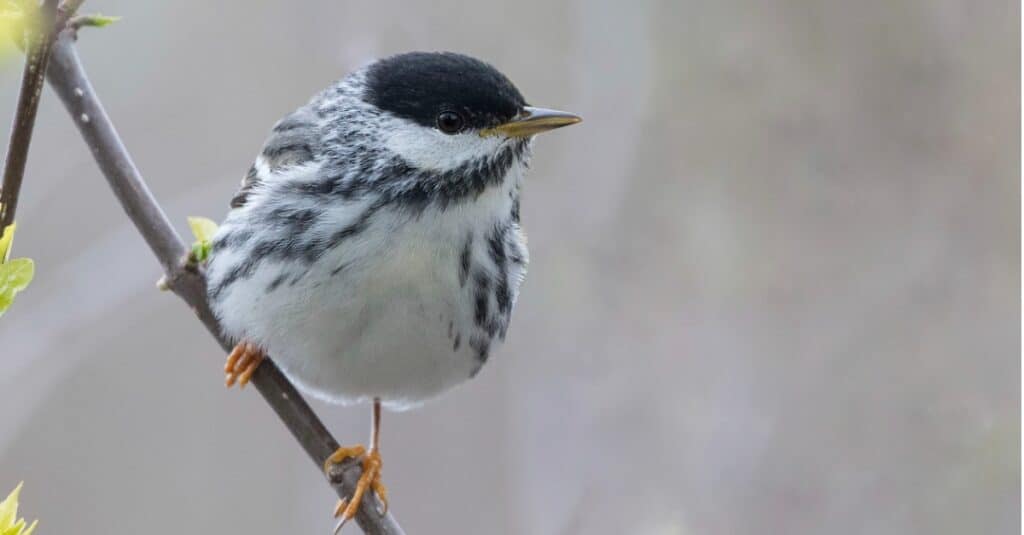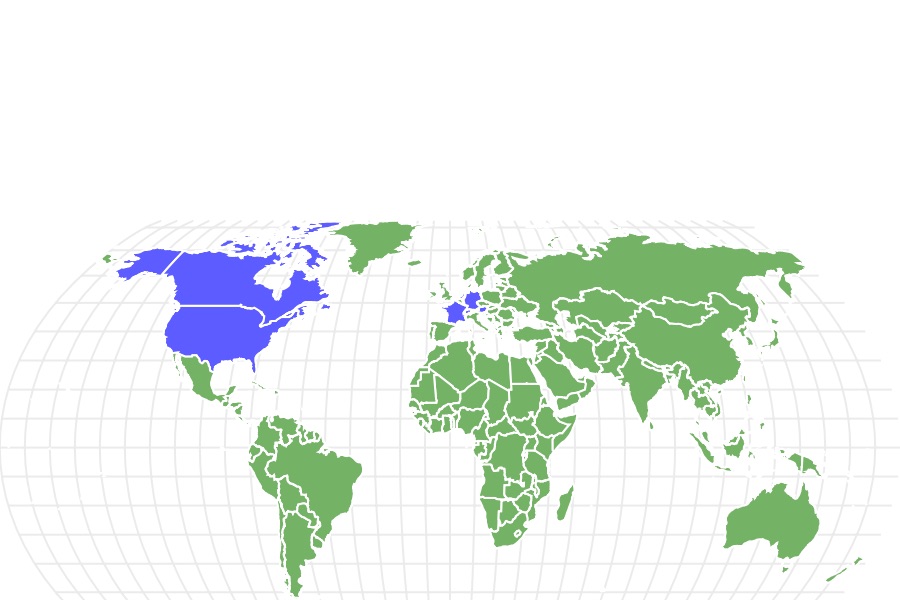Blackpoll Warbler
Setophaga striata
They migrate for the longest distance of any warbler.
Advertisement
Blackpoll Warbler Scientific Classification
- Kingdom
- Animalia
- Phylum
- Chordata
- Class
- Aves
- Order
- Passeriformes
- Family
- Parulidae
- Genus
- Setophage
- Scientific Name
- Setophaga striata
Read our Complete Guide to Classification of Animals.
Blackpoll Warbler Conservation Status
Blackpoll Warbler Facts
- Prey
- Flies, lice, beetles, fruit
- Fun Fact
- They migrate for the longest distance of any warbler.
- Estimated Population Size
- 59,000,000
- Biggest Threat
- habitat loss
- Most Distinctive Feature
- Black feathers on its head (males)
- Other Name(s)
- New World warbler
- Wingspan
- 8-9 inches
- Incubation Period
- 12 days
- Litter Size
- 3-5 eggs
- Habitat
- Evergreen forests and thickets
- Predators
- hawks and snakes
- Diet
- Omnivore
- Type
- bird
- Common Name
- Blackpoll warbler
- Location
- North America, South America, western Europe
- Nesting Location
- in trees- up to 30 feet above the ground
- Age of Molting
- 11-12 days
- Migratory
- 1
View all of the Blackpoll Warbler images!
“These birds fly 72-88 hours non-stop during migration.”
A Blackpoll Warbler is a songbird. It’s an omnivore eating mosquitoes, spiders, flies, and fruit. They live in an evergreen forest habitat. One of the most interesting facts about this bird is it travels non-stop on a migration route that proceeds over water.
4 Incredible Blackpoll Warbler Facts!
- The wingspan of this bird reaches up to nine inches.
- Male birds have an especially high-pitched song.
- It makes a cup-shaped nest out of spruce twigs, lichen, and hair.
- This bird is smaller in size than a sparrow.
Where to Find the Blackpoll Warbler
Blackpoll warblers live in North America, specifically Canada. Their migration route goes through the eastern part of the United States down to the northern part of South America. Though it’s temperate and rainy in some areas of Canada, its habitat is too cold for these songbirds in the wintertime.
Birdwatchers interested in seeing the blackpoll warbler are most likely to see them during the spring and fall seasons. Their migration route covers the eastern part of the United States. So, people can see them in the spring as they head up from South America back to Canada. Alternatively, birdwatchers can see them in the fall as they head south again for the winter. They don’t travel the same migration route for both seasons.
Blackpoll warblers are sometimes heard before they are seen and are known to sing much more in the spring than in the fall season. Plus, the colors of the male are more distinct in the springtime. This makes them easier to spot in their habitat.
Blackpoll Warbler Nests
Female blackpoll warblers usually build their nests in fir or spruce trees, close to the trunk. Some of these songbirds build a nest just six feet above the ground while others build them thirty feet up. The nest is the shape of a cup and with an exterior made of lichen and twigs. The inside of the nest is constructed out of hair or grass. Construction of the nest takes three to four days.
Scientific Name
The scientific name for this songbird is Setophaga striata. The word Setophaga refers to the genus of this bird while the Latin word striata translate to striped. A blackpoll warbler has a striped pattern on its wings. It is in the Parulidae family and the Aves class.
Some other species of warbler include:
- Black-and-white warbler
- Cape May warbler
- Bay-breasted warbler
- Blackburnian warbler
Size, Appearance, & Behavior
The differences in the colors of male and female blackpoll warblers make identification fairly easy. The male blackpoll warbler is named for the cap of black feathers on its head. It has a white breast and black and white stripes on its wings. A female has brown and white streaks on her head. Look closely and you’ll notice a yellowish tinge to the feathers on her head and breast. A female blackpoll warbler’s wings have black or brown and white stripes. The female has muted colors, whereas the male feather colors are bold.
This songbird is small in size at no more than five and a half inches in length. It weighs from 0.4 to 0.5 ounces. The wingspan of this bird is eight to nine inches. One of the most notable facts to use in its identification is this songbird is it has orange feet!

©iStock.com/Cam-Image
Blackpoll Warbler Migration Pattern and Timing
In the fall season, blackpoll warblers migrate south from Canada to South America. Their migration route in the fall runs south from Canada over the eastern part of the United States, over the Atlantic Ocean to the northern part of South America. Many of these tiny songbirds travel non-stop for 72 hours or more on their journey south. These birds travel north in the spring to breed in various parts of Canada. However, their migration route in the spring is not the same as the route they use in the fall.
Diet
This songbird is an omnivore. It finds food on the leaves in the tops of evergreen and deciduous trees.
What Does a Blackpoll Warbler Eat?
The diet of this bird includes spiders, beetles, mosquitoes, ants, and fruit. They increase their intake of food right before they start on their journey south in the fall season.
Predators, Threats, and Conservation Status
These small songbirds have several predators. Other animals attack adult birds as well as the eggs and chicks of blackpoll warblers.
What eats Blackpoll Warblers?
Hawks, owls, snakes, and cats eat adult blackpoll warblers. Blue jays are known to prey on the chicks and eggs of these songbirds.
These birds are categorized as Near Threatened. Their numbers are decreasing due to habitat loss. They are slowly losing their breeding ground made up of forests and shrublands.
Reproduction, Young, and Molting
In the spring, these birds lay from three to five white or pale green eggs with brown spots. The incubation period is 11 to 12 days. The baby birds or chicks, begin molting at around 10 days old. These young birds usually leave the nest at 11 or 12 days old before the molting process is finished.
Some blackpoll warblers have two clutches of eggs each spring.
Warbler Population
According to IUCN, this bird’s conservation status is Near Threatened. Their population is 59,000,000, though it’s reportedly in decline.
View all 284 animals that start with BBlackpoll Warbler FAQs (Frequently Asked Questions)
Does the Blackpoll Warbler migrate?
Yes, this bird migrates every fall and spring season.
How many eggs does the Blackpoll Warbler lay ?
Female Blackpoll Warblers lay three to five eggs. These birds sometimes have two clutches of eggs per spring.
How fast does the Blackpoll Warbler fly?
This songbird can fly 30 to 40 mph. Though this doesn’t seem very fast for a bird of this size, these songbirds cover a lot of territories!
What is the Blackpoll Warbler’s wingspan?
The wingspan of this bird is between eight and nine inches.
When do blackpoll warblers leave the nest?
Chicks leave the nest when they reach 11 to 12 days old. One of the most interesting facts to remember is these chicks usually leave the nest before they’re fully finished molting.
What does a Blackpoll Warbler sound like?
A male Blackpoll Warbler has a high-pitched song. In fact, this bird’s song is so high-pitched, it’s almost impossible for some people to hear. If you hear the song of this bird, it’s likely a male doing the singing.
When does the Blackpoll Warbler migrate?
Blackpoll Warblers migrate in the fall and spring seasons.
What do Blackpoll Warblers eat?
They are omnivores that eat mosquitoes, spiders, beetles, flies, and fruit.
What is the scientific name of the Blackpoll Warbler?
In terms of identification, its scientific name is Setophaga striata.
Where do Blackpoll Warblers migrate to?
These birds live throughout Canada during the breeding season. They migrate south with the arrival of autumn. They travel over a migration route to South America.
These birds return to Canada in the springtime. However, they don’t follow the same migration route as they do in the fall.
Where do Blackpoll Warblers nest?
They nest in spruce or fir trees. A person looking for a Blackpoll Warbler nest can find them anywhere from five feet to 30 feet up in a tree. These birds like to build their nests on a horizontal limb close to the trunk of the tree.
Why is the Blackpoll Warbler endangered?
This bird is Near Threatened due to habitat loss that has resulted in the diminished breeding ground.
How long do Blackpoll Warblers live?
The lifespan of this songbird is three to six years.
Thank you for reading! Have some feedback for us? Contact the AZ Animals editorial team.
Sources
- National Park Service / Accessed December 25, 2021
- Wikipedia / Accessed December 25, 2021
- Thayer Birding / Accessed December 25, 2021
- IUCN / Accessed December 25, 2021
- TN Wildlife Resources Agency / Accessed December 25, 2021
- Pennsylvania Game Commission / Accessed December 25, 2021


















